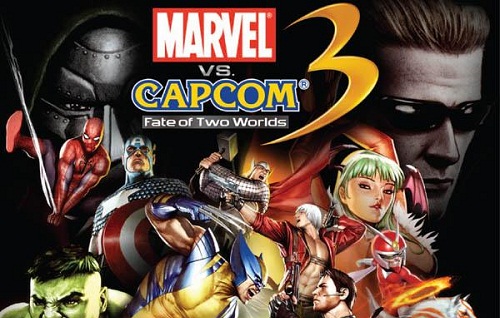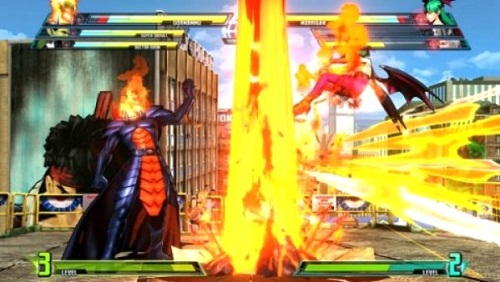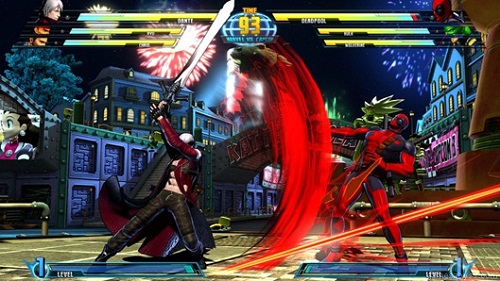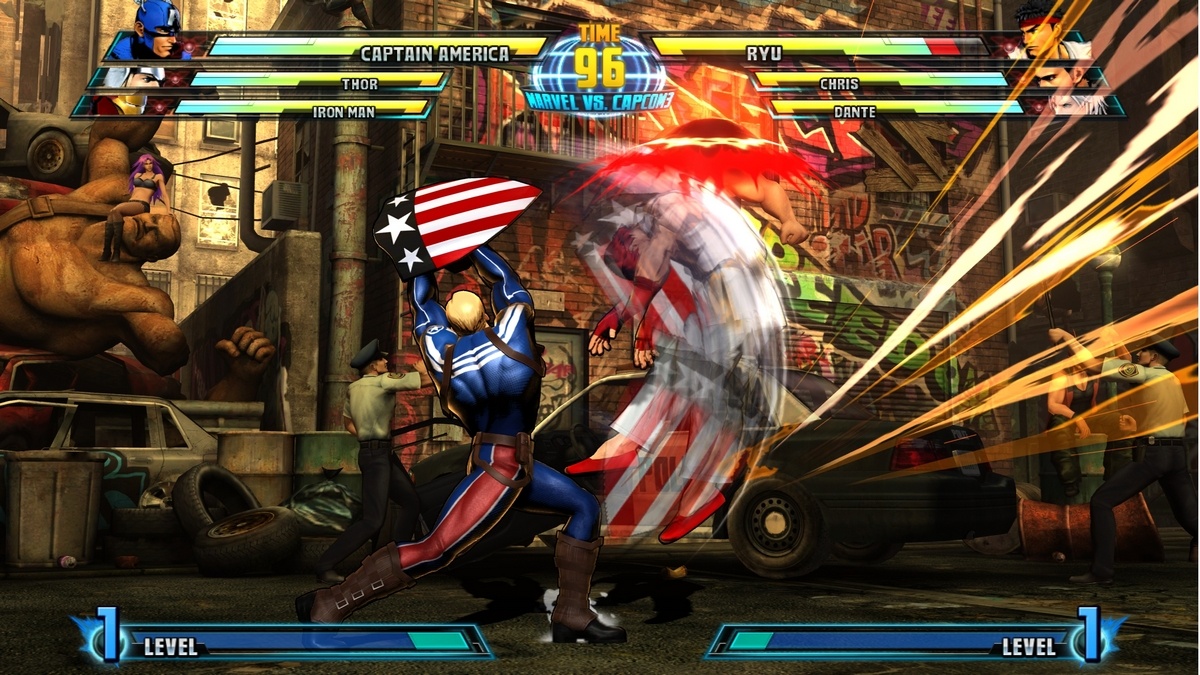What do you get when you mash Capcom’s famous action franchises with the incredible lineage of Marvel’s finest heroes? The same thing we got the last three times this happened; Greatness.
Alexander Sargeant’s Review
I feel silly introducing what is now the fourth in the series of crossover fighters (It all depends on if you count X-men Vs Street Fighter I guess), but it more than deserves the spotlight. Marvel Vs Capcom 3 is a fighting game starring thirty six or so characters from the mythos of either media giant.
The basic form of the fights is this; You can pick three characters to form your team, each with a variety of different special moves and traits. You then take these teams and fight one-on-one with an enemy team, freely swapping out characters as you fight or calling them in to perform an assist attack that you chose before the fight began. Everyone shares a five-level Hyper Combo bar for the -really- special moves, but they each have a separate life bar, so it’s important to not rely on any one fighter for too long if they get badly damaged.
I added the -if- to that, because this is where Marvel Vs Capcom is really interesting. The deck building aspect of the game is insanely compelling, and if you find yourself incredible with a single character thenn you can absolutely rely on them as much as you want. For instance, I use a team of mainly Trish, MODOK and Dormammu. All are pretty unorthodox fighters, a larger trap-to-fist-to-face ratio than most, but they have a decent command of range between them. The best part is that Dormammu has a brilliant close range assist where he creates a dark hole that attacks anyone who steps within a rather large radius. Using that I can keep up projectile attacks from either Trish or Modok, so I don’t even need to swap Dormammu in unless things get really dicey for either of the other fighters.
While saying that, absolutely anyone else playing could fight in an entirely different fashion. There’s an insane amount of choice in this particular version to really let you play out fights the way you wish. The Hyper Combo bar has five levels, and while each Hyper Combo traditionally uses a single bar, some characters have moves that will require a whole three bars to execute. So you could use it for that, or you could call in each of your characters in sequence to perform one hyper combo each, with the effectiveness varying depending on what characters you chose for your team and how that work well together. You can also use your Hyper Combo meter to call in assistant characters while you’re blocking, to interrupt an enemy barrage -by- switching characters.
Then there’s snap-backs, which are free ways to force your opponent to switch their character out, and Team Aerial Combos which’re great for switching through characters while dealing massive damage to the enemy. It’s an extensive and incredibly rewarding system, and the best thing about it for a crossover fighter is that absolutely none of what I just said is difficult to perform. There are only three attack buttons, and you use them for almost everything you do. Familiar fireball motions create the expected result, but using two attack buttons at once out of the light/medium/heavy available rather than just the one will unleash a hyper combo. There’s a fourth button that can be used for certain other attacks and functions, but is primarily a kind of ‘Dust’ attack to borrow a term from Guilty Gear, which is used to send your enemy flying and initiate an aerial combo.
By changing direction and hitting that button you can send the opponent in one of three directions, and if they can hit the same direction with the button at the same time they’re able to counter it. Team Hyper Combos are even just simply doing multiple Hyper Combo motions in a row and there’s even a single button that calls everyone on screen at once to fire with everything they have. For some it might feel a little -too- easy to perform some incredible feats, but I think it’s a great match between the complicated intricacies of BlazBlue and the pick-up-and-play qualities of a Tatsunoko Vs Capcom.
What it can boast above either of those games, is the graphical style of the whole piece. It really is a staggeringly gorgeous fighting game, especially for one that moves as smooth as this does. The comic book style works really well on both the Marvel and Capcom characters, with dark shading suiting Wesker and Dante as you’d expect, but it also fleshes out the 2D designs of characters like Zero and Morrigan successfully as well. There’s nothing else really to say about this. It looks as good as an over the top fighting game can, as far as I know. The soundtrack is also consistently brilliant, with plenty of classic gaming nods as well as recent guilty pleasures, and they play based on what characters are out fighting at the moment. You could have Dante’s rebellious rock anthem kicking in, and then have it switched out for Arthur’s Ghouls and Ghosts styled theme if he takes a turn on the front lines.
Online play works really well too. You will of course have trouble playing with everyone on the planet, but so long as you match your region settings to your own you shouldn’t have much trouble, and I played almost entirely without any lag hiccups for a full two hours of enjoyable and mildly masochistic entertainment. The training mode even has an option to play with a small amount of artificial lag, so if you do have a bit of a connection problem mid-bout you can at least get a feel for how you can function under those conditions. Unfortunately, it is lacking a spectator mode to watch other fights, even in a lobby, so be prepared for a lot of downtime if you’re joining the maxed out eight-player lobby while crude card representations of opposing forces jut about on top of each other with all the menace of the Puppy Bowl.
This isn’t however the only omission. There’s no story mode, with just a simple arcade mode proceeded by a series of stills showing off the different character endings. It would’ve been nice to have just earnt an ending in the form of a comic page, or maybe even a page of an entire 36-page epilogue comic filled in one at a time, but even this is fine. A story mode however could’ve really played around with the various conflicts, old and new between the various casts. I could really see a scenario where Nathan Spencer and Spider-Man team up as he tries to be a better super hero than he was a game protagonist, or even a rivalry story between Dante and Deadpool about who can be the real rebellious bad-ass. There’s so much here that could’ve been easily worked into an entertaining form, but alas arcade mode is all you get.
Seriously, I mean that. If you’re an offline player, you’re going to want to have a friend close by, because there is nothing else to put your time into. There’s a mission mode, which tasks you with completing increasingly difficult combos with each character, but unless you fancy experimenting in there, you are entirely out of luck. Even the customary Survival Mode is absent, and there’s not even a Versus CPU option for you to fight an AI team of your choosing unless you want to try and patchwork it together in Training. These are very peculiar absences in a genre where the barebones package is often criticized, and while Spectator Mode and Shadow Battle, where you fight the AI of various developers and professional players, are said to be on the way no pricing or release dates are known. So I just have to go with what’s here, which isn’t a whole an awful lot for the offline gamer.
That said the point system is rather nice, allowing you to unlock a bunch of artwork and character models to peruse at your leisure, and it’s accrued in any game mode you play, so you never have to play Arcade mode to unlock the four -hidden- characters. There are also a bunch of titles to unlock like Street Fighter IV, which you can use to customise your online card-based persona. It’s also important to remember that unlike many fighting games, MVC3 has actually debuted on consoles. While BlazBlue does offer an insane amount of single-player content, it was also released in Arcades first, where the story groundwork/characters/stages/music and everything else were already implemented, leaving plenty of time in the home conversion to add some awesome extra content. Even then it released with only around twelve characters.
There’s no question that it’s lacking in a lot of offline (and a SINGLE IMPORTANT PIECE OF ONLINE) content, the fact remains that you are still getting for your money an incredibly smooth, engaging battler with thirty six playable characters -so far-, with a well functioning online component that’s both easy to pick up and play for the first time, and yet with enough depth that you could write an article of this length just about picking a perfect team from the damn character select screen. It’s fast, it has broad appeal across all of geek culture, and it feels like no matter how famous or obscure a character you’re playing as you are currently the most overpowered character in the entire game, firing gigantic beams and doling out 100-hit combos as easy as you would greet a person across the road.
The curious omissions and a lack of follow through on some tantalising crossover conflicts leaves this as only -almost- an utterly incredible two-player fighting game for players of all skill levels. B+
Josh Newey’s Review
My relationship with fighters has always been a rather unhealthy one. The love was there, as was the long-term commitment, but all of the fun and excitement of our passionate affair seemed to exist only on the surface. I was completely ignorant of the fighting genre’s intellectual and substantive needs. Instead of loving these games for their brains, I adored them for their intense and entertaining style, gorgeous visuals, and unlimited multiplayer appeal. But no matter how many hours I poured into my avenues for digital fisticuffs, I always felt like I wasn’t connecting with the genre on a mental level. No matter how I tried to understand my mistress’s complex and rewarding design, I simply lacked the dexterity and patience necessary to puncture the surface of heavy makeup and exciting bedroom foreplay to discover the beautiful creature within.
In other words, I suck.
When I first played Marvel Vs Capcom 2, I came to adore the game’s shamelessly tongue-in-cheek campiness, the sheer nerd-tastic girth of the game’s roster, and even though I never learned how to capably string any moves together, the accessibility that came with the endlessly fun and impressively honed gameplay. Even though I was forever doomed to the role of noob/scrub, MVC2 ruled my apartment for months on end.
With the announcement of Marvel Vs Capcom 3, a wave of hope almost overwhelmed the wannabe fighter in me. Could this finally be the title that really clicked well beyond that surface level? Could it be as entertaining or as addictive as one of the greatest arcade fighters to ever grace the Dreamcast?
Well, first and foremost, I can happily report that the euphoric and upbeat presentation of MVC2 has returned in spades. Everything from the overly enthusiastic announcer (shouting cheers like “DUDE!” and “VIEWTIFUL!”) to the ridiculously entertaining hypercombos, to the slightly more tolerable techno-ish music, falls perfectly in line with what the series has delivered thus far. The only major change in those terms comes with a massive injection of delicious fan service seen in every stitch of this game. Perhaps the most immediate example is the replacement of the oddly nebulous and generic stages from previous titles with a handful of character-based arenas. While I would have loved a few more character-specific details in a few of the stages, they do a world of difference in defining the individual identity of each and every hero. That being said, I’m finding myself missing the corny charm of the carnival stage.
The real fan service comes with some of the most detailed and immaculately realized character designs I have ever had the pleasure to experience in a fighting title. Almost every combo, utterance, or movement present in this game has its feet firmly planted in the origins of that character’s identity. Marvel Vs Capcom 2 had a ton of great detail, but nothing it had came close to some of the intricacies in characters like Dante or Deadpool of MVC3. I challenge any fan of Marvel or Capcom, no matter how minor, not to crack a massive grin when Deadpool emphatically mocks Ryu with a loud “SHORYUKEN!” as he uppercuts his opponent, or when Wolverine and X-23 share teacher/student banter in the few moments before a match. That aforementioned interaction is also one of several predisposed conversations and experiences that only occur when certain characters meet each other in the arena. If Amaterasu defeats Felicia in a match, he comments on how the “cat lady” was making eyes at him. If Captain America beats Iron Man, he claims his victory is revenge for Civil War! I know I’m gushing, but as a huge fan of both brands, it’s hard not to appreciate just how much the developers obviously valued the history and nuance of some of these iconic figures.
These beautifully fleshed out fighters are accentuated by a rather attractive graphical style as well, which mixes the expected modernized 3D modeling with the painterly comic book quality of MVC2. Attacks that connect are made all the more satisfying with bright flashes of color that fill the screen, and the announcer’s words are presented with all the energetic flare and cheese of a pulp comic book panel.
This boisterous, flashy style doesn’t end at the graphics, either. The gameplay is incredibly fast and immaculately precise at times, making matches fly by at speeds that feel much more accelerated than in previous entries in the series. Veteran fighters should be able to glean quite a bit of depth from each individual moveset, and less experienced players will probably be pretty surprised to find just how easy it is to perform many of the game’s more intricate combos. MVC3 does offer a much-maligned “simple mode”, which gives the less experienced player an opportunity to utilize a character’s toughest moves at the push of a button, but I implore any intimidated beginner to give the normal mode a try, as combos are surprisingly simple to pull off, especially with controls as precise and responsive as these. Linking combos together is incredibly satisfying and surprisingly easy, making even the most frustrating battles wildly entertaining.
Now, this accessibility is where a lot of more experienced players may be turned off. While the difficulty of Marvel Vs Capcom 3 is certainly substantial, the depth of challenge seems significantly less impenetrable and complex than Capcom’s less arcadey, less accessible fighters. Some of the fastest characters are so easy to use that their movesets become incredibly receptive to speedy button mashing. What results is a sea of beginning online players who clutch desperately to the likes of X-23, Amaterasu, and Zero. Maybe it’s just me challenging my own “skills”, but I found it way too easy to dominate a match using nothing but air combos and hyper combos, an exploit I never experienced with MVC2. As with any Capcom fighter, a truly dedicated player can dig beyond this level of amateurish competition, but just be wary of how many button mashers could potentially hold their own in some online battles. It’s obvious that one of Capcom’s MOs with this title is mainstream accessibility, and they’ve succeeded almost to a fault.
Perhaps the most obvious beginner-friendly element to MVC3 is the inclusion of “Missions.” These bite sized chunks train the player, move by move, how to string together some of the game’s most challenging, intricate combos and to utilize them effectively in battle. This may not seem like that big a deal to some, but I have been begging for this kind of training mode for years. Whereas most fighters just drop a beginner into an arena with one static opponent and an intimidating toolbox of complex moves, MVC3 lets the most incompetent player (*ahem*… me…) develop for himself the seemingly ungodly amount of skill and dexterity necessary to hold his own on the playing field. For players who have been searching for an intuitive, engaging way to learn the ropes, this mode is a godsend. While I can’t say I can now face anyone with a moderate level of skill, I can at least say that these missions have helped me to develop two legs to stand on in my slow progression into knowing what the hell I am doing.
All in all, I can comfortably say that Marvel Vs Capcom 3 easily matches the addictive qualities of its predecessor. While the satisfying sting of difficulty and depth is numbed quite a bit by additions like the simple mode and a painfully easy final boss, the intoxicating concoction of flashy presentation, endless fan service, and beautifully polished gameplay solidifies this as one of the best arcade style fighters in years. Fans of the series will not be disappointed, and the simpler, cornier elements of the game should satisfy hardcore Dreamcasters looking for their next arcadey fix.
I may never have the relationship with fighters that I’ve always wanted. For now though, I’m pretty sure I’m in love with Marvel Vs Capcom 3.
A








